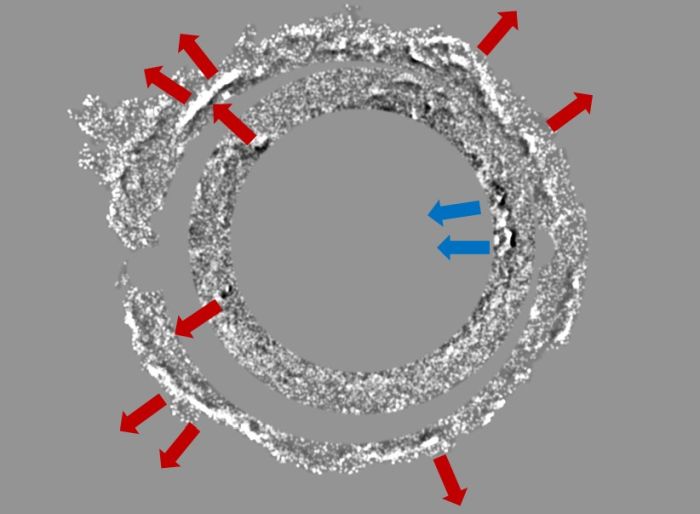From The University of Amsterdam [Universiteit van Amsterdam](NL)
via
29 MARCH 2022
MICHELLE STARR

Multi-wavelength image of Cassiopeia A. Credit: NASA/JPL-Caltech
A new analysis of one of the most famous explosions in the cosmos has revealed a curious asymmetry.
Part of the inner nebula of the Cassiopeia A supernova remnant is not, astronomers have found, expanding evenly.
Something has caused a section of the cloud to move, not outwards with the rest of the material, but inwards, back towards the source of the explosion: a reverse shock.
“The backward movement in the west can mean two things,” says astronomer Jacco Vink of the University of Amsterdam in the Netherlands.
“Either there is a hole somewhere, a kind of vacuum, in the supernova material, causing the hot shell to suddenly move inwards locally. Or the nebula has collided with something.”
Cassiopeia A, located 11,000 light-years away, is one of the most famous and well-studied objects in the Milky Way. It’s what we call a supernova remnant – the expanding cloud of ejecta left over after a massive star has gone kaboom.
The Cassiopeia A supernova is thought to have first been observed in the 1670s, lighting up the sky, and astronomers have been studying the remnant ever since. It’s an excellent sample for studying the evolution of supernovae.
Cassiopeia A emits light in multiple wavelengths, and consists of a large, roughly spherical shell of expanding material, likely ejected prior to the supernova, as the star became increasingly unstable.
This material is expanding at an average rate somewhere between 4,000 and 6,000 kilometers (2,485 and 3,730 miles) per second.
In their new study, Vink and his colleagues studied 19 years’ worth of X-ray data from the Chandra X-ray Observatory to piece together how the remnant has been changing over time.

They found that a section on the west side of the inner region of the shell is bouncing back inwards towards the center, at velocities between 3,000 and 8,000 kilometers per second.
They also found that the outer shock wave of the same section of shell is accelerating. According to computer models of an expanding shock wave, a collision with something will initially cause the shock front to decelerate, and then accelerate: “Exactly as we have measured,” Vink explains.

A map of Cassiopeia A showing its measured expansion. Credit: J.Vink/astronomie.nl.
So what could the shock wave have collided with?
We know from other supernova remnants that material in the space around the star can create reverse shocks; denser regions of interstellar gas and dust, for example, or even a previous, more slowly moving shell of material ejected by the star in its dying throes.
In the case of Cassiopeia A, a dense region of material emitted by the dying star could have produced a partial shell for the remnant to slam into as it expands outwards.
It could also have been the result of a brief Wolf-Rayet phase of extreme mass loss experienced by truly enormous stars that created a cavity in the space around the star.
We don’t actually know much about the progenitor star that created the Cassiopeia A supernova remnant. We don’t know how big it was, how old it was, or what its spectral type was. These results, the researchers say, could provide some clues.
“The shock dynamics reported here provide important hints on the late mass-loss history of the progenitor, be it in the form of a partial, asymmetric shell from episodic mass loss, an aspherical cavity created by a brief Wolf-Rayet phase wind, or perhaps even a combination of both,” they write in their paper.
It’s amazing that new details are still being uncovered in an object as well studied as Cassiopeia A. With new instruments turning their gaze to the object, we can only expect more mysteries to be revealed in the years ahead.
The research has been accepted into The Astrophysical Journal.
See the full article here.
five-ways-keep-your-child-safe-school-shootings
Please help promote STEM in your local schools.
The University of Amsterdam [Universiteit van Amsterdam] (NL) is a public research university located in Amsterdam, Netherlands. The UvA is one of two large, publicly funded research universities in the city, the other being the Free University of Amsterdam [Vrije Universiteit Amsterdam] (NL). Established in 1632 by municipal authorities and later renamed for the city of Amsterdam, the University of Amsterdam is the third-oldest university in the Netherlands. It is one of the largest research universities in Europe with 31,186 students, 4,794 staff, 1,340 PhD students and an annual budget of €600 million. It is the largest university in the Netherlands by enrollment. The main campus is located in central Amsterdam, with a few faculties located in adjacent boroughs. The university is organized into seven faculties: Humanities, Social and Behavioral Sciences, Economics and Business, Science, Law, Medicine, Dentistry.
The University of Amsterdam has produced six Nobel Laureates and five prime ministers of the Netherlands. The university has been placed in the top 100 universities in the world by five major ranking tables. By the QS World University Rankings it was ranked 55th in the world, 14th in Europe, and 1st in the Netherlands in 2022. The UvA was placed in the top 50 worldwide in seven fields in the 2011 QS World University Rankings in the fields of linguistics, sociology, philosophy, geography, science, Economics and econometrics, and accountancy and finance. In 2018 and 2019 the two departments of Media and Communication were commonly ranked 1st in the world by subject by QS Ranking.
Close ties are harbored with other institutions internationally through its membership in the League of European Research Universities , the Institutional Network of the Universities from the Capitals of Europe (EU), European University Association (EU), the International Student Exchange Programs, and Universitas 21.
Research
The University of Amsterdam is one of Europe’s largest research universities, with over 7,900 scientific publications in 2010. The university spends about €100 million on research each year via direct funding. It receives an additional €23 million via indirect funding and about €49 million from commercial partners. Faculty members often receive research prizes and grants, such as those from the Dutch Research Council (NWO – Nederlandse Organisatie voor Wetenschappelijk Onderzoek)(NL). Research is organized into fifteen research priority areas and 28 research institutes within the faculties oversee this research.
The University of Amsterdam has an extensive central University Library (UBA), with over four million volumes. In addition, a number of departments have their own libraries. The main university library is located in the city center. It contains over four million books, 70,000 manuscripts, 500,000 letters, and 125,000 maps, as well as special collections of the Department of Rare and Precious Works, the Manuscript and Writing Museum, the Bibliotheca Rosenthaliana on Jewish history and culture, and the Department of Documentation on Social Movements. Three reading rooms are available for students to study in quiet. In addition to the main University Library, there are approximately 70 departmental libraries spread throughout the center of Amsterdam. The university’s printing arm, the Amsterdam University Press, has a publishing list of over 1,400 titles in both Dutch and English.



